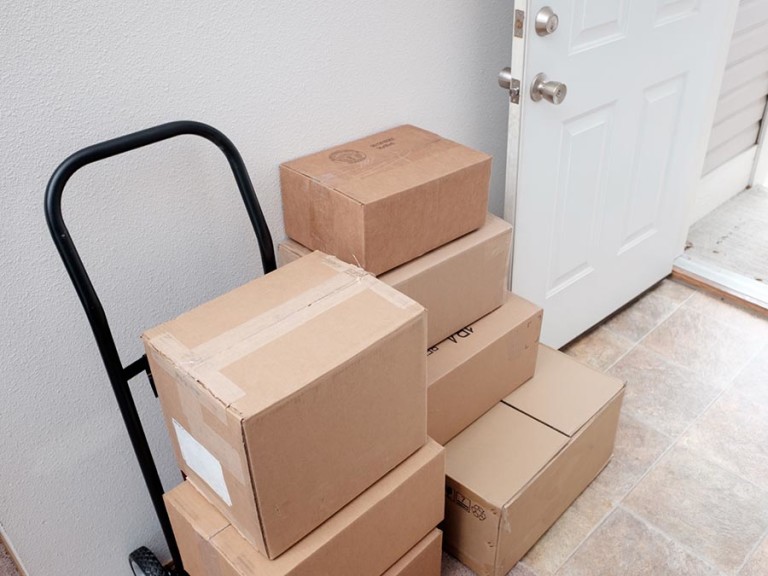Plan your move week by week

8 weeks before moving day: Schedule your movers
If you’re moving across state lines, chances are you’ll be working with a van line, which contract with local movers to transport your possessions from one place to another.
Even if you’re moving within a state, or within a city, van lines are a good place to start looking for a local moving company — it guarantees that they have at one point registered with the Department of Transportation (DOT), and the van line has vetted them
That said, you’ll still want to do a quick background check of a local mover before scheduling an in-home estimate to make sure they don’t have any red flags. Thankfully, the DOT makes it easy. You can use the Federal Motor Carrier Safety Administration’s (FMCSA) search tool to see what complaints a company has had in the last five years, and their safe driving track-record.
To-do:
- Find local agents associated with top van lines
- Schedule at least three in-home estimates and ask:
- How and when the pickup and delivery of your goods will occur
- For contact information for before, during, and after the move
- What happens if an item is damaged during the move
- If the mover has a dispute settlement program
- Compare the whole package — prices and services — before deciding on a mover
6 weeks before moving day: Start downsizing
Moving gives you the opportunity see which belongings you want to bring to your new home, and which you want to leave behind. You’ll want to know the measurements for each room in your new home so you can plan out how — and whether — your existing furniture will fit. If you’re traveling long-distance, you might also consider leaving some of your furniture behind and buying replacements at your destination. Moving estimates take into account weight and volume, so it might be less expensive to sell and replace your furniture than to take it with you — and it’s a good opportunity to upgrade to a new TV or mattress.
You’ll also want to be circumspect about what consumables you bring into your home. Since you’ll need to pack and move any extra supplies, hold off on the Costco-sized package of paper towels. Similarly, start using up your frozen food and pantry items so you won’t have to figure out how to transport ice cream or haul soup cans to your new home.
To-do:
- Measure out your new space
- Determine what furniture you want to keep
- Sell or donate goods
- Start emptying the pantry
- Plan meals to use up perishable items
4 weeks before moving day: Create an inventory and start packing
Now that you’re in the middle of sorting through which belongings you want to pack and which ones you want to sell or donate, you’re ready to start building your inventory list. Having a complete list of all of your books, DVDs, and dishes will not only help you track whether all of your boxes have made it through the move (and which ones might be missing), but will also come in handy if you ever need to submit a homeowners insurance claim for damaged or lost goods.
As you prepare to pack up all of your smaller items, you might want to make use of a packing calculator to estimate how many boxes you need. We like Home Depot’s moving calculator — which asks specifics about the types of rooms you’re trying to pack up.
To-do:
- Estimate the number of boxes you need
- Assess whether you want any specialty boxes:
- Wardrobe boxes
- Dishware boxes
- Picture frame boxes
- TV boxes
- Don’t forget to grab:
- Tape
- Permanent markers
- Packing paper
- Bubble wrap
- Sandwich bags
2 weeks before moving day: Finalize the paperwork
As you get closer to your move-out date, you’ll want to note where your incoming bills and mail are coming from, and update your address with each company. Additionally, you can update your address with the United States Post Office (USPS) to help catch any mail that slipped through your updating efforts.
It can take up to two weeks to process a change of address form through USPS, so you’ll want to give them a heads-up ahead of your actual move-out date. Once filled out, they’ll forward your mail from your old address to your new one for six months — where hopefully you’ll have notified all of your companies, or you can renew the mail-forwarding service for another six months.
This is also a good time to start canceling or transferring your subscriptions — whether a meal delivery service or magazine subscription — and figuring out what steps you need to take to set up utilities at your new place while closing down those at your old one.
To-do:
- Notify jobs, subscriptions, and billing companies of your new address
- Fill out a change of address form at the post office
- Transfer prescriptions to a new pharmacy
- Transfer or set up service with local utilities:
- Electricity
- Water
- Sewage
- Trash
- Internet
1 week before moving day: Finish packing
Even when hiring movers, your actual moving day will be quite busy, so it’s good to make sure your house is as move-ready ahead of time as possible. Try to have everything packed except for your daily necessities and what supplies you’ll need as soon as you get to your new home. Setting aside a specifically-marked “open first” box means you won’t have to open several boxes just to find towels or silverware for your first days in the new home.
Now’s also a good time to finish up last steps in disassembling or cleaning any major appliances you’re taking with you. Research the best way to move each appliance whether it’s your lawnmower (involving removing hazardous liquid and securing the blades) or your refrigerator (which needs to air-dry for at least 24 hours after you’ve defrosted and cleaned it). If there’s any furniture which can be disassembled ahead of moving day, you can save time by doing it now, and placing the smaller parts into labeled zip-lock bags.
If you’re moving into an apartment, you’ll also want to call ahead to see if you can reserve an elevator to help you move. Some buildings require a reservation in order to use an elevator (even if you are moving onto the 30th floor). If you have a reservation, you also won’t have to compete with other residents to use the elevator — making your move in as quick and stair-free as possible.
To-do:
- Pack an “open first” box with a days-worth of essentials
- Photograph assembled electronics before packing
- Disassemble furniture
- Prepare appliances for moving
- Confirm what your movers will and won’t move
- Set aside cleaning supplies for moving day
- If necessary, reserve an elevator or acquire a parking permit in your building
The day of your move
Moving day will be busy, as you’ll be finishing some last-minute packing, answering questions and directing the movers, and cleaning up your home. Make sure to keep your “open first” box separate from the rest of your possessions, as well as any important documents, records, valuables, and moving paperwork. If you’re driving to your new location, you’ll want to keep these with you, or explain to your movers how you want your antique furniture handled.
This is also your time to follow the movers as they do their own inventory of your household goods. They’ll note exactly what is going onto the truck, as well as the condition of your furniture and possessions. It’s important to be on the same page, so that if damages occur during transit, you have a written record of what dings were already present in your furniture, and which need to be reimbursed by your moving company’s protection policy.
To-do:
- Be present and available the whole day to help the movers
- Accompany the movers as they inventory your belongings
- Take pictures of any existing damage
- Carefully read all documents before signing them
- Keep the bill of lading until your goods are delivered, the charges are paid, and any claims are settled


